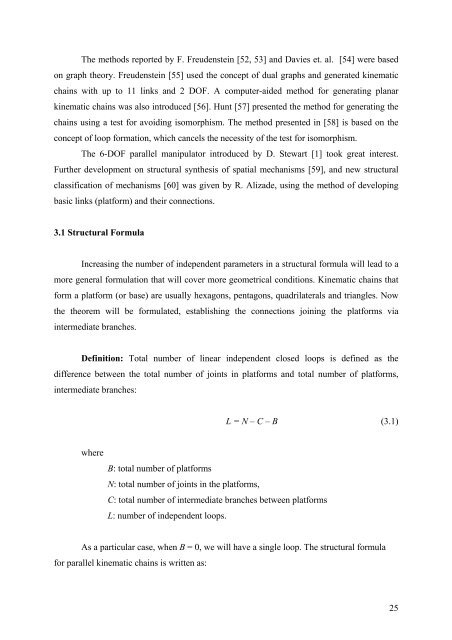Kinematic and Dynamic Analysis of Spatial Six Degree of Freedom ...
Kinematic and Dynamic Analysis of Spatial Six Degree of Freedom ...
Kinematic and Dynamic Analysis of Spatial Six Degree of Freedom ...
You also want an ePaper? Increase the reach of your titles
YUMPU automatically turns print PDFs into web optimized ePapers that Google loves.
The methods reported by F. Freudenstein [52, 53] <strong>and</strong> Davies et. al. [54] were based<br />
on graph theory. Freudenstein [55] used the concept <strong>of</strong> dual graphs <strong>and</strong> generated kinematic<br />
chains with up to 11 links <strong>and</strong> 2 DOF. A computer-aided method for generating planar<br />
kinematic chains was also introduced [56]. Hunt [57] presented the method for generating the<br />
chains using a test for avoiding isomorphism. The method presented in [58] is based on the<br />
concept <strong>of</strong> loop formation, which cancels the necessity <strong>of</strong> the test for isomorphism.<br />
The 6-DOF parallel manipulator introduced by D. Stewart [1] took great interest.<br />
Further development on structural synthesis <strong>of</strong> spatial mechanisms [59], <strong>and</strong> new structural<br />
classification <strong>of</strong> mechanisms [60] was given by R. Alizade, using the method <strong>of</strong> developing<br />
basic links (platform) <strong>and</strong> their connections.<br />
3.1 Structural Formula<br />
Increasing the number <strong>of</strong> independent parameters in a structural formula will lead to a<br />
more general formulation that will cover more geometrical conditions. <strong>Kinematic</strong> chains that<br />
form a platform (or base) are usually hexagons, pentagons, quadrilaterals <strong>and</strong> triangles. Now<br />
the theorem will be formulated, establishing the connections joining the platforms via<br />
intermediate branches.<br />
Definition: Total number <strong>of</strong> linear independent closed loops is defined as the<br />
difference between the total number <strong>of</strong> joints in platforms <strong>and</strong> total number <strong>of</strong> platforms,<br />
intermediate branches:<br />
where<br />
L = N – C – B (3.1)<br />
B: total number <strong>of</strong> platforms<br />
N: total number <strong>of</strong> joints in the platforms,<br />
C: total number <strong>of</strong> intermediate branches between platforms<br />
L: number <strong>of</strong> independent loops.<br />
As a particular case, when B = 0, we will have a single loop. The structural formula<br />
for parallel kinematic chains is written as:<br />
25
















